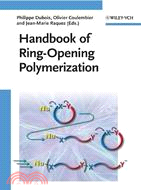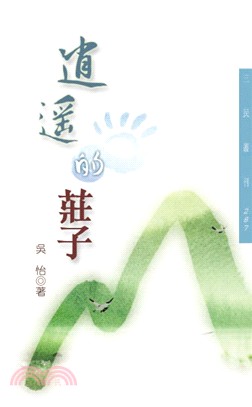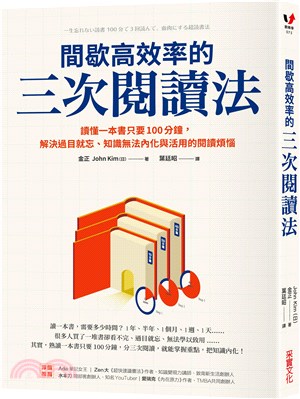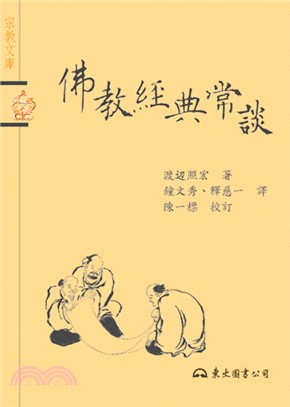HANDBOOK OF RING-OPENING POLYMERIZATION
- ISBN13:9783527319534
- 出版社:JOHN WILEY & SONS;LTD
- 作者:DUBOIS
- 裝訂/頁數:精裝/425頁
- 出版日:2009/01/28
商品簡介
Of much interest to chemists in academia and industry.
作者簡介
Olivier Coulembier received his PhD degree from University of Mons-Hainaut, Belgium in 2005 and joined the University of Stanford (United States) for his postdoctoral research in 2006. He is currently Research Associate by Belgian F.R.S.-FNRS in the Laboratory of Polymeric and Composite Materials (Professor Philippe Dubois) at University of Mons-Hainaut. His main activities are focused on the (non)organometallic ring-opening polymerization of cyclic monomers. He has authored 24 scientific papers in international journals.
Jean-Marie Raquez, PhD in chemistry um UMH, Belgium, is currently postdoctoral researcher by Belgian F.R.S.-FNRS and works in the Laboratory of Polymeric and Composites Materials (Professor Philippe Dubois) at University of Mons-Hainaut (UMH) in Mons, Belgium. He has authored 12 scientific papers and 5 US patents in Materials Technology including macromolecular synthesis and reactive processing. In 2004, he joined the Michigan State University, USa, for his postdoctoral research.
目次
List of Contributors.
1 Thermodynamics and Kinetics of Ring-Opening Polymerizatio (Andrzej Duda and Adam Kowalski).
1.1 Introduction.
1.2 Thermodynamics of the Ring-Opening Polymerization.
1.2.1 Equilibrium Monomer Concentration: Ceiling/Floor Temperatures.
1.2.2 Selected Particular Cases.
1.2.2.1 Polymerization in Heterogeneous Systems.
1.2.2.2 Monomer–Polymer–Solvent Interactions.
1.2.2.3 Thermodynamics of Oligomerization.
1.2.3 Thermodynamics of Macrocyclization.
1.2.4 Equilibrium Copolymerization.
1.2.5 Molar Mass Distribution in the Equilibrium Polymerization.
1.3 Kinetics of Ring-Opening Polymerization.
1.3.1 Thermodynamic and Kinetic Polymerizability.
1.3.2 Kinetics of Living Polymerization.
1.3.2.1 Kinetic Criteria of Living Polymerization.
1.3.2.2 Active Center Interconversions and the Determination of Absolute Rate Constants.
1.3.2.3 Departure from Livingness: Kinetics of Selected Side Reactions.
1.3.2.4 Kinetics of Copolymerization.
1.4 Concluding Remarks.
References.
2 General Mechanisms in Ring-Opening Polymerization (Takeshi Endo).
2.1 Introduction.
2.2 Anionic Ring-Opening Polymerization.
2.2.1 General Mechanism.
2.2.2 Activated Monomer Mechanism.
2.3 Cationic Ring-Opening Polymerization.
2.3.1 General Mechanism.
2.3.2 Activated Monomer Mechanism.
2.3.3 Isomerization Polymerization.
2.4 Radical Ring-Opening Polymerization.
2.5 Summary and Prospects.
References.
3 Siloxane-Containing Polymers (François Ganachaud and Sylvie Boileau).
3.1 Introduction.
3.2 Polydimethylsiloxanes.
3.2.1 Anionic Polymerization.
3.2.1.1 General Considerations.
3.2.1.2 Recent Advances.
3.2.2 Cationic Polymerization.
3.2.2.1 General Considerations.
3.2.2.2 Recent Advances.
3.2.3 Emulsion Polymerization.
3.2.3.1 General Considerations.
3.2.3.2 Recent Advances.
3.2.4 Other Processes.
3.3 Functional Silicones.
3.3.1 Anionic Polymerization.
3.3.1.1 Homopolymerization of Symmetrical Cyclosiloxanes.
3.3.1.2 Homopolymerization of Asymmetrical Cyclosiloxanes.
3.3.1.3 Copolymerization.
3.3.2 Cationic Polymerization.
3.3.2.1 Homopolymerization of Symmetrical Cyclosiloxanes.
3.3.2.2 Homopolymerization of Asymmetrical Cyclosiloxanes.
3.3.2.3 Copolymerization.
3.3.3 Emulsion Polymerization.
3.4 Polycarbosiloxanes.
3.4.1 Five-Atom Rings.
3.4.2 Larger Cyclocarbosiloxanes.
3.5 Summary and Prospects.
Acknowledgments.
References.
4 Sulfur–Nitrogen–Phosphorus-Containing Polymers (Frederick F. Stewart and Eric S. Peterson).
4.1 Introduction.
4.2 Mechanism and Methods in Ring-Opening Polymerization (ROP) of Halogenated Cyclotriphosphazenes.
4.3 Ring-Opening Polymerization and Chemistry of Nonhalogenated Phosphazene Rings.
4.4 Incorporation of Sulfur into Phosphazene Ring Systems, and Their Polymerization Chemistry.
4.4.1 Thiophosphazenes.
4.4.2 Thionylphosphazenes.
4.5 Summary and Prospects.
Acknowledgments.
References.
5 Polymerization of Cyclic Depsipeptides, Ureas and Urethanes(Pieter J. Dijkstra).
5.1 Introduction.
5.2 Polydepsipeptides.
5.3 Monomers.
5.4 Ring-Opening Polymerization.
5.5 Enzymatic Polymerization.
5.6 Ring Expansion.
5.7 Polyureas.
5.8 Polyurethanes.
5.9 Summary and Prospects.
References.
6 Polyethers and Polyoxazolines (Richard Hoogenboom).
6.1 Introduction.
6.2 Polyethers.
6.2.1 Poly(ethylene Oxide).
6.2.2 Poly(oxetane).
6.2.3 Poly(tetrahydrofuran).
6.3 Polyoxazolines.
6.4 Summary and Prospects.
Acknowledgments.
References.
7 Polyamides (Jan Roda).
7.1 Introduction.
7.2 Mechanism of the Anionic Polymerization of Lactams.
7.3 Initiators for the Anionic Polymerization of Lactams.
7.4 Activators for Anionic Polymerization of Lactams.
7.4.1 N-Acyllactams.
7.4.2 N-Carbamoyllactams.
7.4.3 Special Activators.
7.5 Nonactivated Polymerization.
7.6 Cyclic Oligomers of å-Caprolactam
7.7 Block Copolymers of Lactams.
7.8 Anionic Copolymerization of å-Caprolactam with ù-Laurolactam.
7.9 Copolymerization of Lactams with Lactones (å-Caprolactone).
7.10 Powdered Polyamide.
7.11 Nanocomposites.
7.12 Anionic Polymerization of 2-Pyrrolidone.
7.13 Summary and Prospects.
Acknowledgments.
References.
8 Ring-Opening Metathesis Polymerization (Michael R. Buchmeiser).
8.1 General Introduction.
8.2 Introduction to Ring-Opening Metathesis Polymerization (ROMP).
8.3 Well-Defi ned Catalysts for ROMP.
8.3.1 Schrock-Type Initiators.
8.3.2 Grubbs-Type Initiators.
8.4 ‘Living’ ROMP.
8.4.1 ROMP with Schrock Initiators.
8.4.2 ROMP with Grubbs-Type Initiators.
8.5 Selected Recent Applications and Developments.
8.5.1 Novel Catalysts for ROMP.
8.5.2 ROMP of High and Low Ring-Strain Monomers.
8.5.3 Stereoselective and Regioselective ROMP.
8.5.4 Mechanistic Investigations.
8.5.5 Alternating Copolymerizations.
8.5.6 Changes in Polymerization Mechanism.
8.5.7 Materials Science.
8.5.8 ROMP in Water and in Ionic Liquids.
8.5.9 Computational Studies.
8.6 Summary and Prospects.
References.
9 Polyesters from β-Lactones (Olivier Coulembier and Philippe Dubois).
9.1 Introduction.
9.2 â-Lactones Preparation.
9.3 Ionic Polymerization.
9.3.1 Anionic Processes.
9.3.2 Carbocationic Process.
9.4 Coordination Process.
9.5 Carbene-Based Polymerization.
9.6 Enzymatic Polymerization.
9.7 Illustrative Experimental Section.
9.7.1 Anionic Ring-Opening Polymerization of Benzyl â-Malolactonate.
9.7.2 Synthesis of Poly([R,S]-â-Butyrolactone), á-Methoxy, ù-Carboxylic Acid from Commercially Available 5-Methoxy-1,3,4-Triphenyl-4,5- Dihydro-1H-1,2-Triazol-5-Ylidene Carbene.
References.
10 Polyesters from Dilactones (Odile Dechy-Cabaret, Blanca Martin-Vaca, and Didier Bourissou).
10.1 Introduction.
10.2 General Concepts and ROP Promoted by Metallic Catalysts/Initiators.
10.2.1 O-Donor Ligands.
10.2.2 N-Donor Ligands.
10.2.3 N,O-Donor Ligands.
10.3 Recent Advances in ROP.
10.3.1 Metal-Free ROP.
10.3.1.1 Nucleophilic/Basic Catalysts.
10.3.1.2 Cationic Polymerization.
10.3.1.3 Bifunctional Catalysts.
10.3.2 Stereocontrolled ROP.
10.3.2.1 rac-Lactide.
10.3.2.2 meso-Lactide.
10.4 Macromolecular Engineering.
10.4.1 ‘Modifi ed’ PLGAs: Alternative Monomers to Lactide and Glycolide.
10.4.2 Macromolecular Architectures.
10.4.2.1 Linear Block Copolymers.
10.4.2.2 Grafted Block Copolymers.
10.4.2.3 Star and Dendritic Polymers.
10.5 Applications.
10.6 Summary and Prospects.
Acknowledgments.
References.
11 Polyesters from Large Lactones (Ann-Christine Albertsson, Indra K. Varma, and Rajiv K. Srivastava).
11.1 Introduction.
11.2 Controlled Synthesis of Linear Polyesters.
11.2.1 Nonenzymatic Methods of Polymerization.
11.2.2 Enzymatic Methods of Polymerization.
11.2.2.1 The Mechanism of Enzyme-Catalyzed ROP.
11.2.3 Copolyesters.
11.2.4 Functionalized Polyesters.
11.2.5 Chemospecifi c Polymerization.
11.2.6 Enantioselective Polymerization.
11.3 Physical Properties of Polymers.
11.4 Summary and Prospects.
References.
12 Polycarbonates (Helmut Keul).
12.1 Introduction.
12.2 Polymerization of Cyclic Carbonates: Homopolymers and Block Copolymers.
12.2.1 Initiation.
12.2.1.1 Alkali Metal-Based and Metal-Free Initiators.
12.2.1.2 Initiators for a Coordination–Insertion Mechanism.
12.2.2 Chain Propagation.
12.2.2.1 Alkali Metal Alcoholate and Phenolate Active Sites.
12.2.2.2 Metal-Free Active Sites: Site Transformation from Group Transfer Polymerization to Anionic Metal-Free Polymerization.
12.2.2.3 Magnesium, Aluminum and Zinc Alcoholate Active Sites.
12.2.3 Monomers and Homopolymers.
12.2.4 Block Copolymers Comprising a Polycarbonate Block.
12.2.5 Copolymerization of Cyclic Carbonates with Lactones.
12.3 Summary and Prospects.
References.
13 Polymerization of Cycloalkanes (Jacques Penelle).
13.1 Introduction.
13.2 General Overview and Thermodynamic Requirements.
13.3 Structure–Reactivity Relationships Based on a Comprehensive Survey of the Current Literature.
13.3.1 The Polymerization of Monocyclic Alkanes.
13.3.1.1 Cyclopropane Rings.
13.3.1.2 Cyclobutane Rings.
13.3.2 The Polymerization of Polycyclic Rings.
13.3.3 Unusual Examples.
13.4 Summary and Prospects.
References.
14 Metal-Free Catalysis in Ring-Opening Polymerization (Andrew P. Dove).
14.1 Introduction.
14.2 Nucleophilic ROP.
14.2.1 Tertiary Amines and Phosphines.
14.2.2 N-Heterocyclic Carbenes.
14.2.3 Supramolecular Activation.
14.2.4 Other Nucleophilic ROP Catalysts.
14.3 Metal-Free Ionic ROP.
14.3.1 Cationic.
14.3.2 Anionic.
14.4 Summary and Prospects.
References.
15 Enzyme-Mediated Ring-Opening Polymerization (Andreas Heise, Christopher J. Duxbury, and Anja R. A. Palmans).
15.1 Introduction.
15.2 Characteristics of Enzymatic ROP.
15.3 Classes of Monomer.
15.3.1 Lactones.
15.3.1.1 Substituted Lactones.
15.3.2 Lactides/Glycolide/Depsipeptides and Cyclic Diesters.
15.3.3 Cyclic Carbonates and Cyclic Phosphates.
15.4 Polymer Architectures Employing Enzymatic ROP.
15.4.1 Block Copolymers.
15.4.2 Graft Copolymers.
15.4.3 Branched and Crosslinked Polymers.
15.5 Summary and Prospects.
References.
Index.
主題書展
更多主題書展
更多書展本週66折
您曾經瀏覽過的商品
購物須知
為了保護您的權益,「三民網路書店」提供會員七日商品鑑賞期(收到商品為起始日)。
若要辦理退貨,請在商品鑑賞期內寄回,且商品必須是全新狀態與完整包裝(商品、附件、發票、隨貨贈品等)否則恕不接受退貨。

























